
The Acrididae are the predominant family of grasshoppers, comprising some 10,000 of the 11,000 species of the entire suborder Caelifera. The Acrididae are best known because all locusts are of the Acrididae. The subfamily Oedipodinae is sometimes classified as a distinct family Oedipodidae in the superfamily Acridoidea. Acrididae grasshoppers are characterized by relatively short and stout antennae, and tympana on the side of the first abdominal segment.

Bandwings, or band-winged grasshoppers, are the subfamily Oedipodinae of grasshoppers classified under the family Acrididae. They have a worldwide distribution and were originally elevated to full family status as the Oedipodidae. Many species primarily inhabit xeric weedy fields, and some are considered to be important locusts:

The grasshopper subfamily Acridinae, sometimes called silent slant-faced grasshoppers, belong of the large family Acrididae in the Orthoptera: Caelifera.
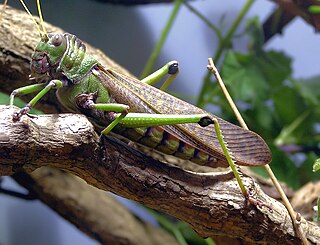
The Romaleidae or lubber grasshoppers are a family of grasshoppers, based on the type genus Romalea. The species in this family can be found in the Americas.
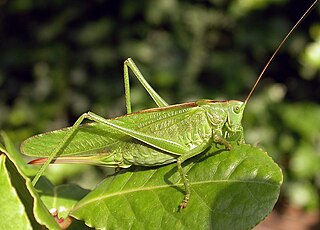
The Tettigoniinae are a subfamily of bush crickets or katydids, which contains hundreds of species in about twelve tribes.
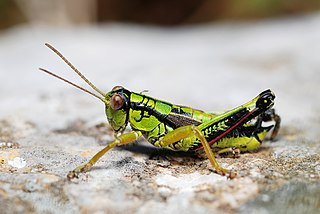
Miramella is a small genus of short-horned grasshoppers in the subfamily Melanoplinae. They are found in Europe and eastern Asia. As of January 2019, Orthoptera Species File lists seven species in three subgenera. The genus was first named in 1932. Miramella is the type genus of the subtribe Miramellina.
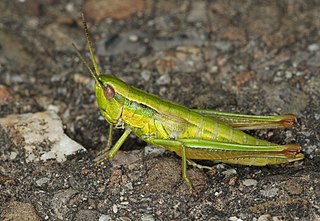
Gomphocerinae, sometimes called "slant-faced grasshoppers", are a subfamily of grasshoppers found on every continent but Antarctica and Australia.
Eumastacidae are a family of grasshoppers sometimes known as monkey- or matchstick grasshoppers. They usually have thin legs that are held folded at right angles to the body, sometimes close to the horizontal plane. Many species are wingless and the head is at an angle with the top of the head often jutting above the line of the thorax and abdomen. They have three segmented tarsi and have a short antenna with a knobby organ at the tip. They do not have a prosternal spine or tympanum. Most species are tropical and the diversity is greater in the Old World. They are considered primitive within the Orthoptera and feed on algae, ferns and gymnosperms, the more ancient plant groups.
The Tristiridae are a family of grasshoppers, in the Orthoptera: suborder Caelifera. Species in this family can be found in the Americas.
Podismini is a tribe of "spur-throated grasshoppers" in the family Acrididae. This tribe is unlike others in the subfamily Melanoplinae in that a substantial number of genera occur outside the Americas.
Melanoplini is a tribe of spur-throated grasshoppers in the family Acrididae. There are about 19 genera and more than 200 described species in Melanoplini, all in North America. Their biogeography shows that many species in the tribe have descendants from the Eocene epoch and Miocene epoch.

Romaleinae is a subfamily of lubber grasshoppers in the family Romaleidae, found in North and South America. More than 60 genera and 260 described species are placed in the Romaleinae.

Rhammatocerus is a genus of grasshoppers in the subfamily Gomphocerinae and the tribe Scyllinini. There are about 16 described species in Rhammatocerus, including R. schistocercoides, the "Mato Grosso locust".

Copiocerinae is a subfamily of short-horned grasshoppers in the family Acrididae. There are at least 20 genera in Copiocerinae, found in southern North America, Central America, and South America.

Orphulella is a genus of slant-faced grasshoppers in the family Acrididae. There are more than 20 described species in Orphulella, all found in the Americas.

Leptysminae is a subfamily of spur-throat toothpick grasshoppers in the family Acrididae. There are at least 20 genera in Leptysminae, found in North, Central, and South America.

Proctolabinae is a subfamily of grasshoppers in the family Acrididae. There are more than 20 genera and 210 described species which are found in South America.
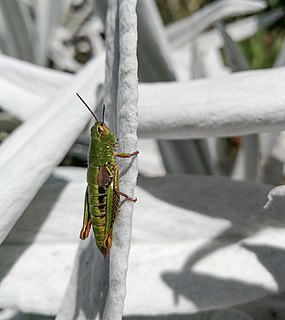
Jivarus is a genus of spur-throated grasshoppers in the family Acrididae. There are more than 20 described species in Jivarus, found in Ecuador, Colombia, and Peru.



















